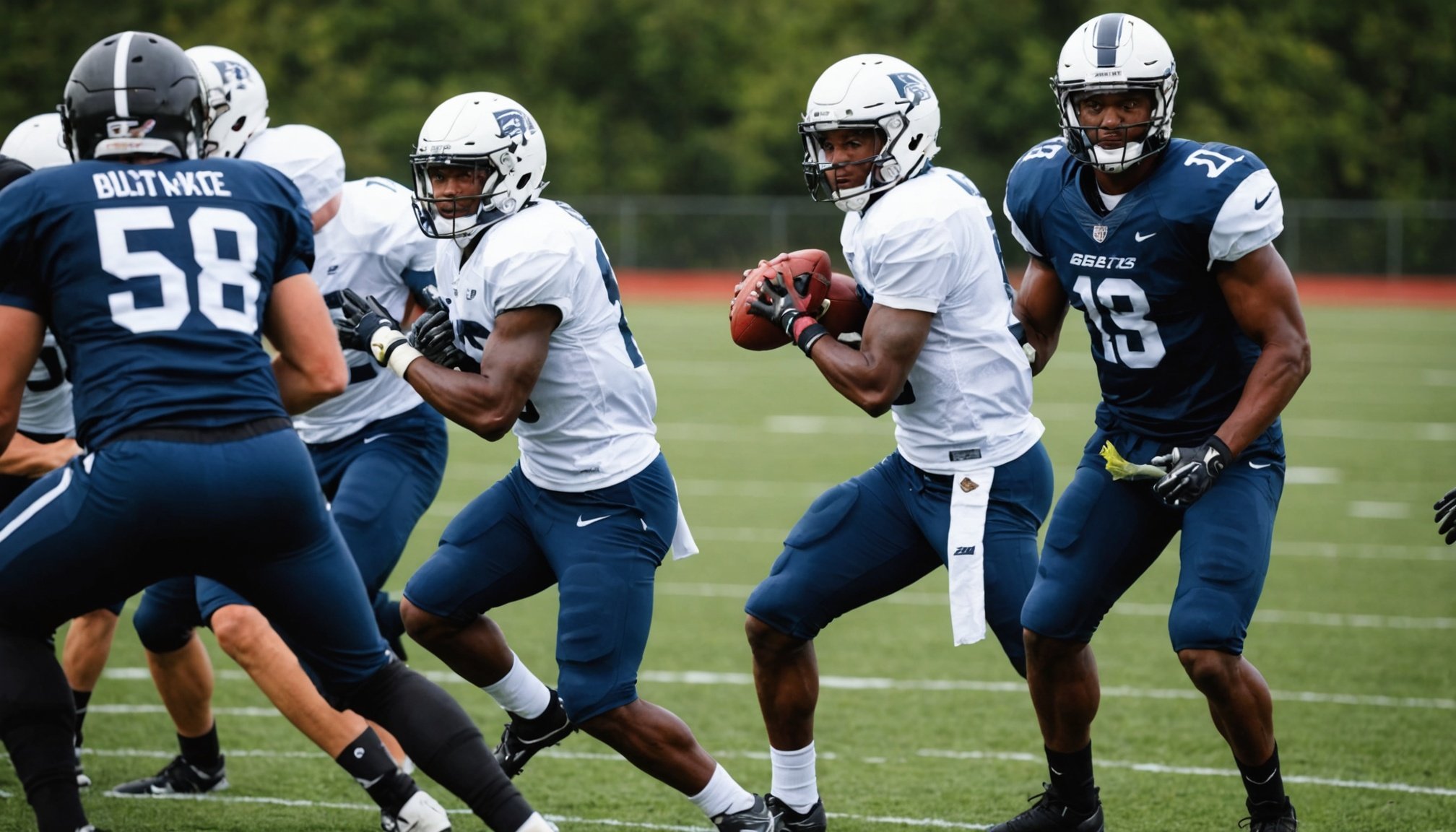Overview of Reaction Time in Football Defending
In the fast-paced world of football, reaction time is crucial for defenders. It determines how quickly a defender can respond to an opponent’s movements. A split-second delay can be the difference between a successful block and a goal against the team. The importance of drills cannot be underestimated as they are designed to enhance a defender’s ability to react swiftly and effectively during critical moments.
Defensive performance heavily relies on fast reaction times. Quick responses help in intercepting passes, tackling opponents, and positioning oneself advantageously. This ability to anticipate and act is vital to thwarting attacking plays and preventing the opposition from scoring.
In the same genre : Maximizing Player Performance: Strategic Travel Planning for UK Football Teams to Combat Fatigue
Defenders often face common challenges that test their reaction time. These include sudden changes in direction by attackers, deceptive body movements, and fast-paced dribbling. Each of these scenarios needs rapid cognitive and physical responses to maintain defensive strength.
Football defending is not merely about physical prowess but also involves sharp mental acuity. Effective drills aim to simulate real-game conditions, allowing defenders to refine their reaction times. These drills often involve exercises that enhance agility, speed, and decision-making under pressure. Developing these skills can significantly boost a defender’s on-field performance.
Have you seen this : Unlocking Peak Performance: The Advantages of Mental Resilience Training for Football Athletes
Key Drills to Enhance Reaction Times
Improving reaction time is pivotal for defenders aiming to succeed in football training. Implementing a blend of drills for defenders not only improves swift responses but diversifies the learning process.
Overview of Types of Drills
A comprehensive football training regimen includes reflex training, shadow drills, and cone drills. Reflex training harnesses unpredictable stimuli to encourage quicker responses. Shadow drills require defenders to mimic an attacker’s movements, fostering anticipation and agility. Cone drills enhance footwork and direction change, integral for proficient defense.
Importance of Variety in Training Methods
Variety in drills plays a crucial role. It prevents monotony, engages different muscle groups, and addresses multiple facets of reaction times. Different drills inject novelty, keeping the training engaging while targeting diversified skills.
Guidelines for Choosing the Right Drill
Selecting the appropriate drill depends on the defender’s current skills and the specific reaction time improvement needed. Consider the defender’s strengths and weaknesses; some may require enhancing footwork, while others need sharper reflexes. It is essential to assess the level of match readiness, combined with observing physiological feedback during training, to tailor the most effective drills. By implementing a calibrated mix of exercises, defenders can significantly progress in their reaction time, bolstering their performance on the field.
Detailed Breakdown of Top Drills
Exploring specific drills can elevate your football performance. By understanding drill instructions and the essence of varied football exercises, players can enhance their agility, reaction time, and overall game skills. Let’s delve into the nuances of these excellent drills.
Ladder Drill
The Ladder Drill, a cornerstone in football exercises, focuses on agility and coordination. For this drill, lay a ladder flat on the ground. Begin by stepping in and out of the squares as swiftly as possible, maintaining light feet and proper form. Aim for 2-3 sets, lasting 60 seconds each, three times a week. To maximize effectiveness, increase your speed progressively and incorporate varied patterns to challenge yourself further.
Cone Reaction Drill
To set up the Cone Reaction Drill, arrange cones in a zigzag formation approximately 2 feet apart. The objective here is to weave through the cones rapidly, reacting to a coach’s signal or an external cue. Perform this drill for 2-4 minutes per session, twice a week. For optimal results, maintain a low body posture and focus on quick direction changes.
Partner Reaction Drill
This drill enhances not only reaction speed but also teamwork. Stand opposite your partner, who acts as the stimulus by moving unpredictably. Mirror your partner’s movements for 3-5 minutes per session, twice a week. By keeping your senses alert and observing your partner closely, you can unlock the potential of these specific drills for significant improvement.
Equipment and Safety Considerations
When engaging in football training, having the right training equipment is crucial for optimal performance and injury prevention. Essential items include cones for agility drills, hurdles for jump training, resistance bands for strength exercises, and footballs for technical skills. Ensuring you have quality, well-maintained equipment helps reduce accidents and facilitates effective practice sessions.
Equally important are the safety measures implemented during each training session. Proper football training safety protocols involve wearing appropriate gear like helmets and shin guards, ensuring a safe playing surface, and conducting regular equipment checks. These measures are paramount in minimizing risks associated with intense physical activities.
Injury prevention goes beyond equipment and protocols; it’s also about preparing the body thoroughly. The importance of proper warm-up and cool-down routines cannot be overstated. A thorough warm-up increases blood flow to muscles, enhancing flexibility and reducing strain. A cool-down helps in muscle recovery and reduces stiffness, aiding in the acceleration of recovery.
In conclusion, combining the appropriate training equipment with strict adherence to safety measures creates a secure environment conducive to effective learning and performance improvement in football training. Understanding and implementing these considerations can lead to safer, more enjoyable, and productive training sessions.
Tracking Progress and Measuring Improvement
Effectively tracking progress in reaction time is crucial for optimizing your training routine. Utilising a variety of techniques can lead to significant improvements over time. Begin by implementing a reaction time assessment, which provides a baseline for your current performance. This assessment can be as simple as a timed response test, allowing for precise measurement of your ability to react swiftly and accurately.
To ensure continuous measuring improvement, consider setting specific benchmarks. These benchmarks not only serve as goals but also motivate consistent training efforts. For example, aim for a reduction in your reaction time by 5% within a month. Regular evaluations against these benchmarks enable you to adjust your training strategies effectively.
Another essential aspect is the role of feedback in your progress tracking. Feedback, whether from a coach or self-analysis, allows for real-time adjustments and fosters growth. It highlights areas needing more focus and encourages you to adapt your methods. In response to feedback, employ targeted exercises to enhance weak points.
In conclusion, progress tracking, reaction time assessments, and feedback are foundational to measuring improvement. By incorporating these strategies, you build a robust framework for continuous enhancement of your reaction times.
Visual Aids and Resources
Incorporating visual learning is crucial for grasping drills effectively. Visual aids, such as diagrams and instructional videos, offer tangible examples, making complex techniques more accessible. When learners see the drills in action, comprehension improves significantly, allowing for a more nuanced understanding of strategies and methodologies.
Training Resources
Numerous training resources are available online, offering a wealth of video demonstrations and visual materials. Platforms like YouTube host extensive libraries of free content, where coaches and enthusiasts share their expertise through detailed breakdowns of drills. Likewise, specialised websites offer curated training sessions, combining video demonstrations with written guidance, to cater to different learning styles.
Tips for Creating a Visual Training Guide
Creating your own visual training guide can be an invaluable resource for both personal reference and sharing with others. Start by breaking down each drill into smaller, manageable steps. Use high-quality images or sketches alongside brief explanations to illustrate each phase. For video content, focus on clarity: ensure good lighting and a steady camera. Collaborating with others or seeking feedback can also refine the final product. Keeping these elements in mind will support a more effective and engaging learning experience through visual aids.
Conclusion: Elevate Your Game
Improving reaction times is not just about winning a match; it’s about elevating performance on and off the pitch. Enhanced reaction times can significantly boost your football skills by allowing you to respond swiftly to opponents’ moves. This skill can turn a standard player into a formidable presence on the field.
To achieve continuous improvement, it is crucial to be dedicated and consistent in practising drills. Regular drills hone reflexes and improve your ability to predict others’ actions. This repetition forms a strong foundation, offering an edge over competitors who may not practice as diligently.
Continuously seeking new techniques and knowledge is just as important. Resources such as training videos, podcasts, and expert coaching sessions can provide valuable insights into the myriad ways one can improve. Staying educated helps refine football skills, allowing you to keep up with the ever-evolving nature of the sport.
Thus, take a proactive approach in your journey by incorporating consistent practice and seeking additional resources. Embrace this commitment to growth and witness transformative changes in your game. When executed with purpose and dedication, these strategies ensure you’re always a step ahead, ready to tackle whatever comes your way.
















